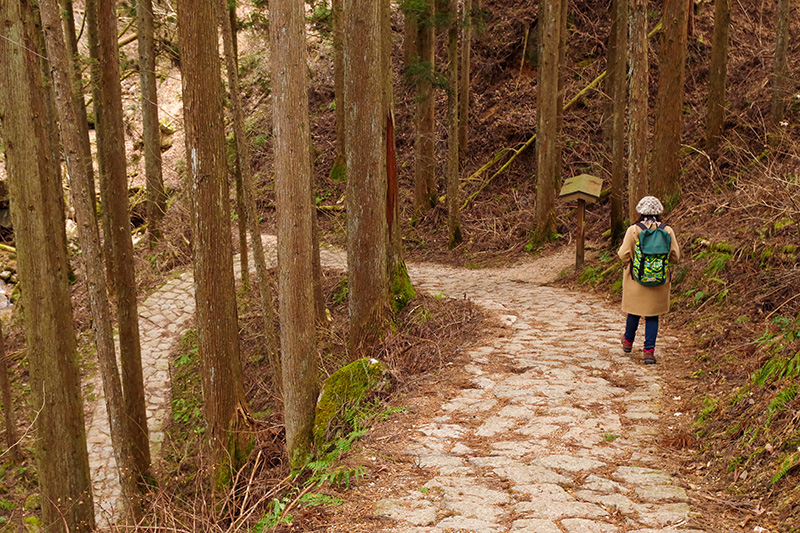Several hundred years ago, five roads, called the Gokaido, were built to connect Japan to the capital of Edo. The most heavily-traveled and famous of which was the Tokaido, still in commercial use today. The longest, however, was the Nakasendo. Stretching from Sanjo Ohashi in Kyoto to Nihonbashi in Edo, it covered a distance of around 534 kilometers and had 69 post-towns along its route—26 of which are located in Nagano prefecture.
Due to the Nakasendo’s difficult terrain, it is not as heavily traveled as its sibling so much of its history remains intact. Many people come to visit the most famous post-towns, and others hike different sections of the road, whether it’s a trek between just two towns or a journey that crosses several prefectures. For people interested in Japanese history, architecture or hiking, the Nakasendo is a must-see.
The most famous portion of the Nakasendo today runs between Magome and Tsumago post towns at the southern edge of the Kiso Valley.
The Post Town of Tsumago-juku

Tsumago is a quiet stretch of wooden inns and houses at the southern end of the Kiso Valley. Extending for several hundred meters along the Nakasendo, it supported travelers on their way between Edo and Kyoto for hundreds of years.
The town looks just as it did during its heyday. Ancient inns, their rooves weighted with heavy stones, line the street. Colorful flowers and noren curtains decorate their exteriors. At night, they are illuminated by nothing but the warm glow of paper lanterns. As you walk along Tsumago, you’ll feel as if you’ve slipped back in time to another era.

Among the post town’s many inns, there was one main inn, called Honjin, and a secondary inn, called Wakihonjin. These larger accommodations hosted important government officials. Tsumago’s Wakihonjin remains open today as a museum. Looking inside, you can get a glimpse into the lifestyles of people during the Edo Period. The wakihonjin’s staff explain everything from their most famous former guests to how families spent their evenings during the long, cold winters. And if you visit during winter, you can even see heavenly rays of sunlight beaming through the inn’s lattice windows.
Walking the Nakasendo trail
From Tsumago, most travelers head south to Magome. The section of the Nakasendo between the two post towns is about eight kilometers long, taking around two to three hours to complete. After passing a few houses on the outskirts of town, the Nakasendo disappears into the forests of Kiso.

The trail is shaded by tall cypress trees. It winds up the hillside over many switchbacks, passing old monuments and shrines along the way. Every so often, the forests give way to small clearings with rice fields, scattered farmhouses, and the occasional hamlet.

Half-way along the trail is a lone teahouse run by a local volunteer. He invites travelers inside, serving them tea and candy and chatting with them about their trips. People from all over stop here on their walk along the Nakasendo, exchanging stories with one another during their short breaks.
From the rest house, Magome Pass (790m) is another kilometer along the trail. After the pass, the trail begins to descend and the narrow valley of Kiso opens up, revealing a vast, hilly landscape. The trail passes more farms and fields with a few sleepy shibas lazing in the sun.
After about 30 more minutes, the trail reaches Magome.
Arriving in Magome

Unlike its counterpart in the Kiso Valley, Magome sits on a wide-open plain with excellent views of Mt. Ena and the surrounding landscape. From the top of the hill, blue mountains seem to extend infinitely into the distance.
From here, Magome descends the hillside for several hundred meters. Its main street is paved with chiseled stones and lined with elegant buildings in the Edo-period style, their facades a contrast of dark wooden beams and white plaster walls. At the bend in the road is the post town’s iconic waterwheel.

The post town features more shops than inns, selling popular snacks such as oyaki dumpling, gohei-mochi rice cakes, and local sakes. There are plenty of cafes and restaurants to sit down for a rest and a bite to eat as well.
Both post towns are great examples of Japan’s Edo period architecture and atmosphere. By walking between them along the Nakasendo, you can imagine yourself in the shoes of a traveler who walked this same road hundreds of years ago. See the remnants of the Nakasendo’s past and interact with the friendly locals that live along the Nakasendo to this day.

Access and Other Information
Baggage Delivery between Tsumago and Magome
If you have a lot of luggage and don’t want to carry it all on your walk between Tsumago and Magome, you can have it delivered from one post town to the other. Baggage delivery is offered from late March until the end of November. Bags can be dropped off at the Magome or Tsumago Tourist Information Center between 8:30 and 11:30, and can be picked up at your destination’s tourist information center after 13:00. One bag costs 1,000 yen.
How to Get to Tsumago and Magome
Tsumago and Magome are located along the JR Chuo Main line between Nagoya and Shiojiri stations.
To get to Tsumago, take a limited express train from Nagano station to Shiojiri station (60min.) and changed to the JR Chuo line to reach Nagiso station (90min.). From there, take the Magome line bus to Tsumago.
To get between Magome and Nagatsugawa Station, take the Magome-Nakatsugawa bus. From there, you can take the limited express train to Nagoya (55min.) or back towards Matsumoto (75min.) or Nagano (125min.).























